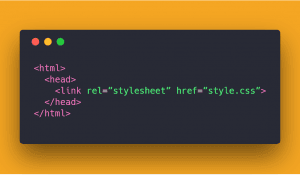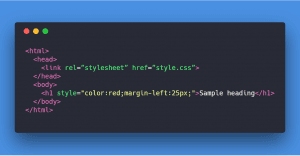A Cascading Style Sheet, commonly known as CSS, is the layer of styling over HTML elements, or in simpler terms, it lets you style the elements (font, size, color, and spacing) of your HTML pages and content by gently applying classes to it. CSS takes care of the presentation and helps you determine how the pages and content that you make with HTML are going to look and display. CSS will be a savior once you have learned to master the code. To master CSS, you first need to understand the different types of CSS. There are basically three ways of writing CSS, which are mentioned below.
Internal Style Sheet
Using an internal style sheet means that whatever style you are going to create is going to be coded right into the HTML of that particular page just between the and tags. It is used if you want the style to be used in the complete HTML body.
For example: 
External Style Sheet
Using an external style sheet means you create a .css file and then use it in your HTML page as per your requirements. Generally, external CSS is used when you have many HTML attributes and you wish to use them as required; there is no need to write and rewrite the CSS style again and again in the HTML body. It is recommended to use an external style sheet majorly for two reasons.
- It saves a lot of your page’s loading time.
- It is convenient to have just about everything in one place.
For example: 
Inline CSS
Using an inline CSS means that every style of content is going to be in HTML elements. It is used for a limited section and in case your requirements are very small because it will affect only a single element. If you are a good programmer, it is not recommended to use inline CSS because:
- It is time-consuming to specify the CSS on every HTML tag.
- The code will become quite large and complex.
For example:  An internal style sheet is generally used by bloggers, an external style sheet is used in WordPress, and inline CSS is useful in need of quick fixes.
An internal style sheet is generally used by bloggers, an external style sheet is used in WordPress, and inline CSS is useful in need of quick fixes.
CSS Features
1. Consistency
With CSS, it is easy to make changes to the pages of your website. By making one change to your CSS stylesheet, you can consequently make it to each page of your website.
2. Browser Compatibility
Browser compatibility is something that is very important and with CSS, it is easy to withhold as it addresses this issue nicely.
3. Appearance
With CSS, it is easy to improve the look-and-feel of the website from one place as it allows you to use a wide array of extensive and expressive styles.
4. Maintainability
CSS offers you the ability to automatically correct and change every page throughout your website whenever a change is made to your website’s style sheet.
5. Saves Time
With CSS, you only need to specify details of the styling once for any element and it will automatically apply the specified styles whenever that particular element occurs. Hence, it saves a lot of time by not forcing you to rewrite everything again and again.
Major Differences Between CSS, CSS2 & CSS3
- CSS was originally released in 1996 and consists of properties for adding font properties such as typeface and emphasis color of text, backgrounds, and other elements. CSS2 was released in 1998 with added styles for other media types so that it can be used for page layout designing. CSS3 was released in 1999 and presentation-style properties were added in it that allows you to build a presentation from documents.
- Unlike CSS2, which was comprised of a single document, CSS3 has its specifications divided into many individual modules, which makes CSS3 a whole lot easier to handle.
- With CSS3, the designers can now use special fonts, like those available in Google Fonts and Typecast. Earlier, with CSS and CSS2, designers could only use “web-safe fonts” for being 100% sure to use fonts that would always display the same on every machine.
- While CSS and CSS2 had ‘simple selectors’, CSS3 calls the components as ‘a sequence of simple selectors’.
- CSS3 came up with some key web design considerations like rounded borders that help in rounding up the borders without any hassle. This turned out to be a huge plus point for developers who were struggling with initial versions of CSS borders.
- CSS3 has the capability to split text sections into multiple columns so that it can be read like a newspaper. In CSS2, the developers had difficulty because the standard was not equipped with automatically breaking the text so that it fits within a box.
What and where to learn in 2024?
CSS is a web development technology that stands behind the look-and-feel of every web page. It is proving to be capable to do so much more with its most recent evolution. The versions of CSS just keep getting better and better with time, which basically means an improved programming platform for developers, resulting in more efficient and faster web designs.
As we make our way through, the most in-demand and important visual language of the web is CSS3. It helps you to engage your website users with fast loading web pages across all browsers.
CSS3 lets you gain control over the visual appearance of your website by means of layout, layering, typography, and special effects. You can easily customize any theme for WordPress or can create the visual for your app or site with CSS3.
You can find the programming community-recommended best CSS3 tutorials here.
Difference Between CSS, CSS2 And CSS3
|
Parameters |
CSS |
CSS2 |
CSS3 |
|
Released In |
1996 |
1998 |
1999 |
|
Specification |
Single Document |
Single Document |
Divided into individual modules |
|
Styling Option |
Limited |
More than CSS |
Large, along with the support for animations |
|
Fonts |
Web-safe fonts |
Web-safe fonts |
Special fonts analogous to Google Fonts and Typecast |
|
Selectors |
Simple selectors |
Simple selectors |
A sequence of simple selectors |
|
Rounded Borders |
No |
No |
Yes |
|
Split Text Feature |
No |
No |
Yes |
|
Grid System and Template Layout |
No |
No |
Yes |
Build Responsive Real World Websites with HTML5 and CSS3
Conclusion
CSS3 is the latest version of CSS. It is only compatible with IE9 and not with older versions of browsers. The more you code, the more you will learn about CSS3 but there is one thing to note -- you cannot master CSS3 unless you know about CSS. CSS3 took the properties of CSS and developed them to include new features to provide ease of use to the designers.
CSS3 is capable of supporting responsive designs and can also handle media queries as compared to CSS, which does not support responsive design and is not capable of handling media queries. CSS3 is very important for web designers because it provides a vast range of options and it helps in creating more enhanced opportunities for designing a webpage. Through web designing, marketers can increase their product awareness in the market easily.
People are also reading:
- Types of CSS
- CSS Interview Questions
- Download CSS Cheat Sheet
- Best CSS Editor
- CSS Frameworks
- Differences between CSS, CSS2, and CSS3
- Difference between HTML, HTML5 and XML
- Top Angular Alternatives
- Best Angular IDE
- Top Angular Interview Questions and Answers
- Download Bootstrap Cheat Sheet
- Top Bootstrap Interview Questions and Answers
